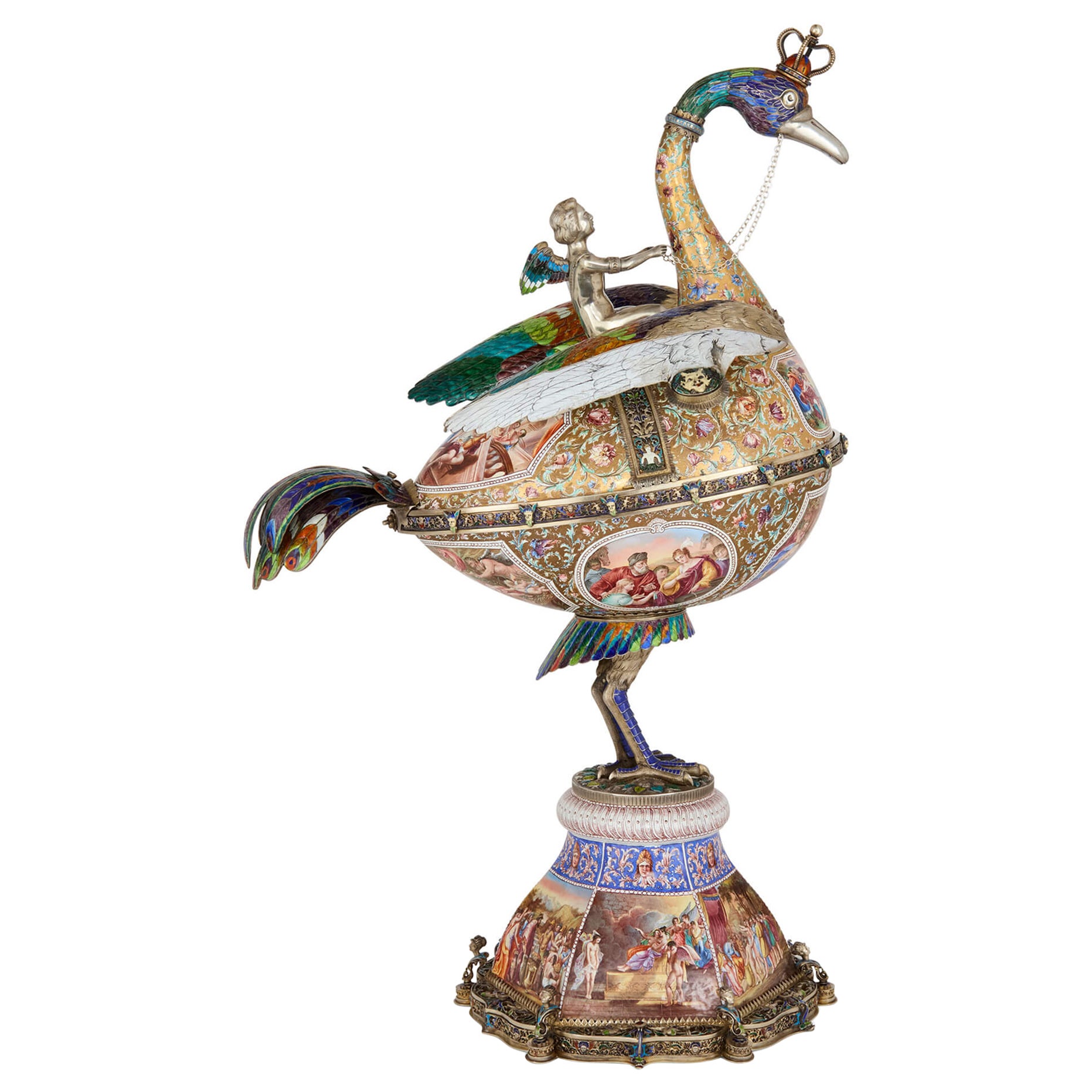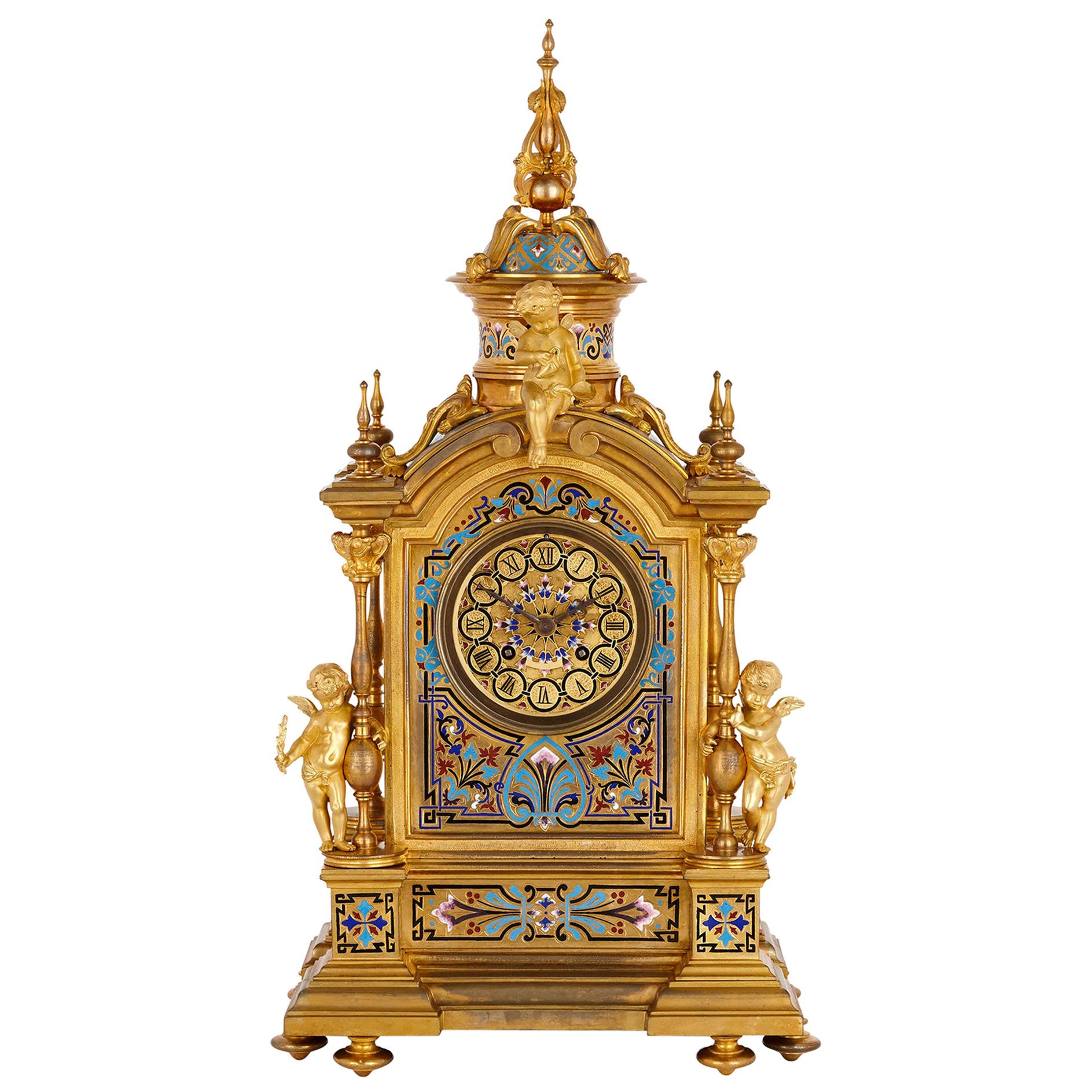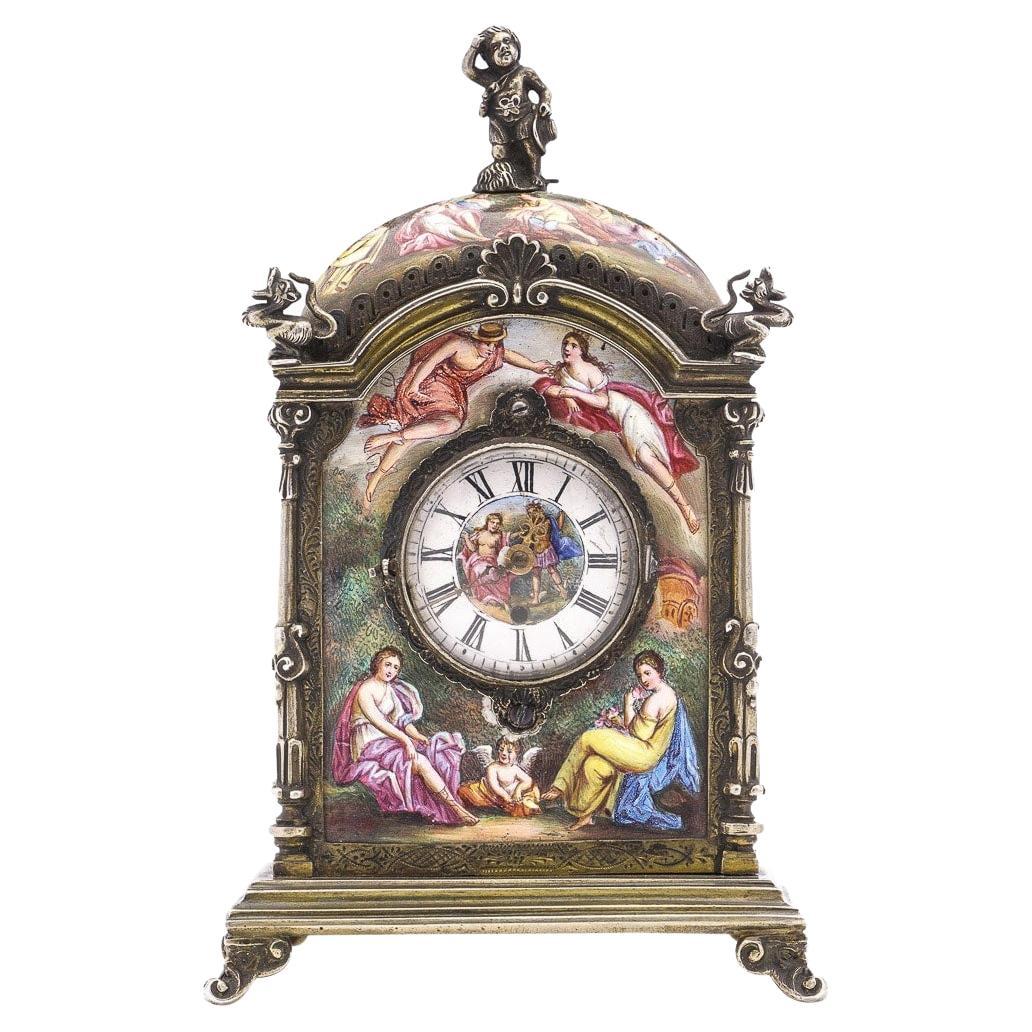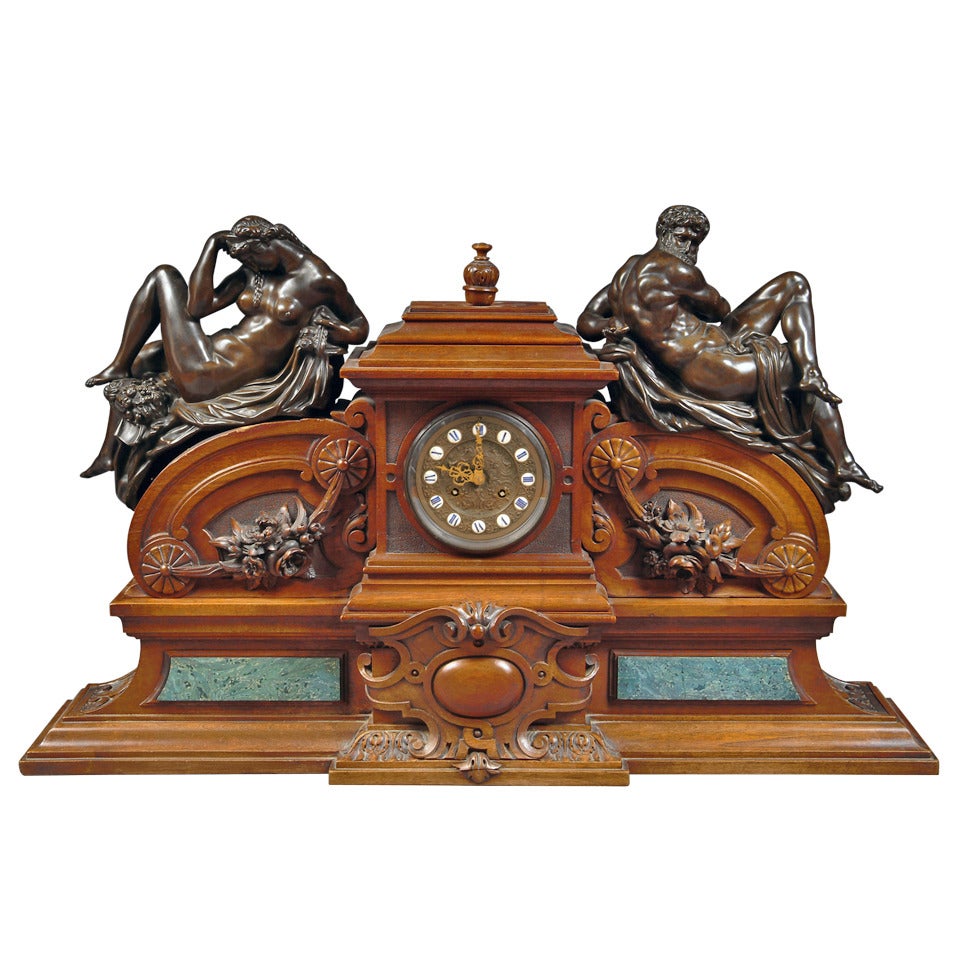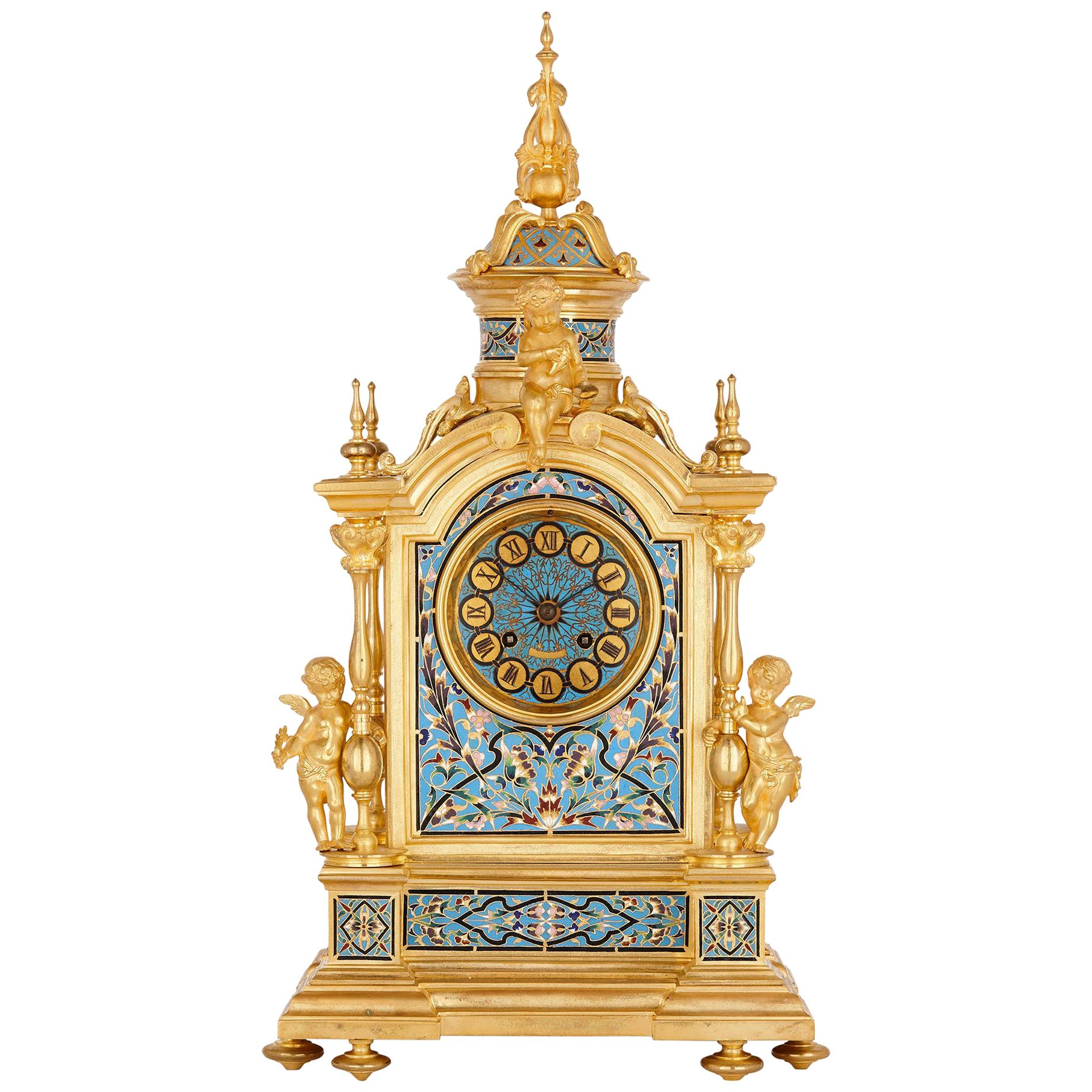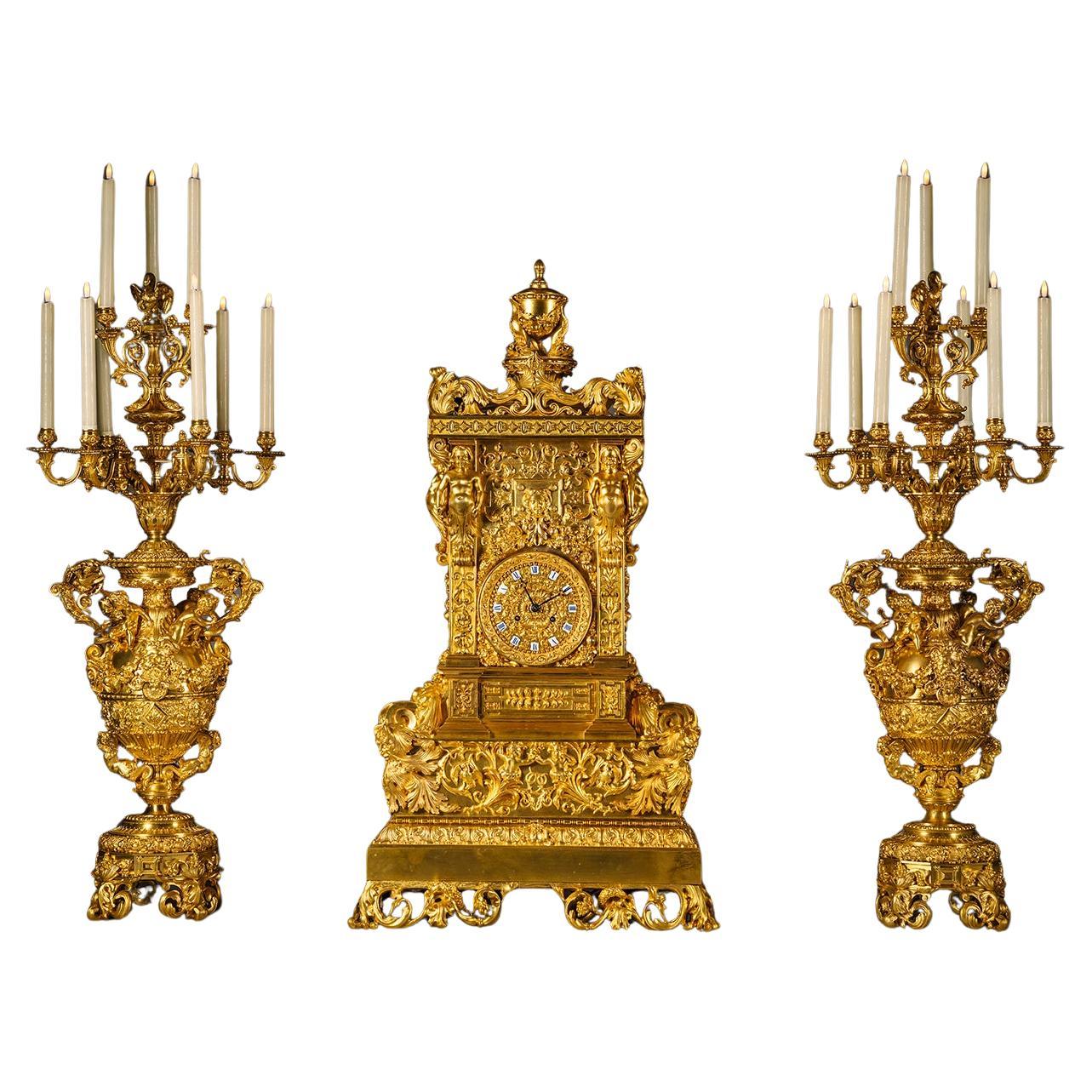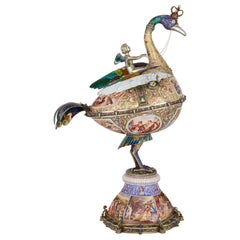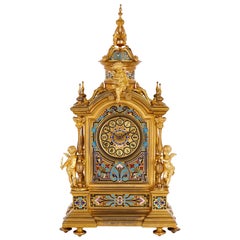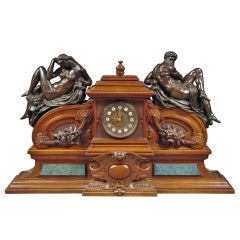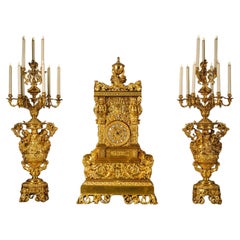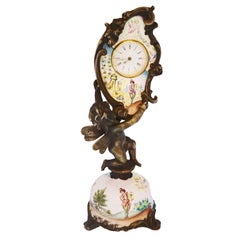Items Similar to Large Austrian Renaissance Revival Silver and Enamel Clock by Hermann Böhm
Want more images or videos?
Request additional images or videos from the seller
1 of 16
Large Austrian Renaissance Revival Silver and Enamel Clock by Hermann Böhm
About the Item
Large Austrian Renaissance Revival silver and enamel clock by Hermann Böhm
Austrian, c. 1880
Height 64cm, width 29cm, depth 29cm
An exquisite example of 19th century craftsmanship, this extraordinary Viennese clock was created around 1880 by Hermann Böhm, a distinguished Austrian artisan celebrated for his elaborate and luxurious decorative pieces. Böhm founded his studio in 1866 and swiftly gained international prestige.
Masterfully designed in the Renaissance Revival style, this four-tier architectural masterpiece showcases a rich blend of artistry and opulence. The lower two levels are adorned with hand-painted mythological vignettes in vibrant polychrome hues, each enclosed within maroon cartouches dotted with delicate detail. Surrounding the scenes are intricate gilt backgrounds with flowing floral patterns, further enhancing the visual grandeur.
Elegant spiral-moulded columns, accented with white enamel, gilt floral elements, and inset gemstones, frame each panel. Atop these columns stand striking figures of Roman warriors, posed in vigilant stances that echo classical heroism.
The third level features a unique pentagonal shape, with each facet displaying pierced silver enamel panels. At the heart of each panel is a finely detailed clock dial, where black Roman numerals contrast beautifully against vivid blue enamel. Ruby-toned gems add a touch of regal brilliance. Charming silver figurines, consistent with the tiers below, grace the corners to complete the design.
Above this sits a smaller, similarly shaped tier, containing niches filled with miniature silver and enamelled sculptures of animals and human figures rather than timepieces. Crowning the entire structure is a domed enamel top, intricately painted and surmounted by a striking representation of Triton, the mythological sea god, astride a fantastical sea creature.
The clock is supported by a decorative base as elaborate as the main body, featuring shaped feet adorned with grotesque enamelled masks and finishing in sculptural lion’s paws.
Throughout the piece, silver marks for ‘HB’ (Hermann Böhm) and ‘A’ (Austria) can be found, affirming its authenticity and origin.
A testament to Viennese artistry and luxurious design, this antique clock is an exceptional acquisition for collectors of fine European decorative arts.
- Creator:Hermann Böhm (Maker)
- Dimensions:Height: 25.2 in (64 cm)Width: 11.42 in (29 cm)Depth: 11.42 in (29 cm)
- Style:Renaissance Revival (Of the Period)
- Materials and Techniques:
- Place of Origin:
- Period:
- Date of Manufacture:c. 1880
- Condition:Wear consistent with age and use.
- Seller Location:London, GB
- Reference Number:Seller: 178571stDibs: LU956345338712
About the Seller
5.0
Recognized Seller
These prestigious sellers are industry leaders and represent the highest echelon for item quality and design.
Established in 1975
1stDibs seller since 2012
409 sales on 1stDibs
Typical response time: 6 hours
Associations
The British Antique Dealers' AssociationInternational Confederation of Art and Antique Dealers' Associations
- ShippingRetrieving quote...Shipping from: London, United Kingdom
- Return Policy
Authenticity Guarantee
In the unlikely event there’s an issue with an item’s authenticity, contact us within 1 year for a full refund. DetailsMoney-Back Guarantee
If your item is not as described, is damaged in transit, or does not arrive, contact us within 7 days for a full refund. Details24-Hour Cancellation
You have a 24-hour grace period in which to reconsider your purchase, with no questions asked.Vetted Professional Sellers
Our world-class sellers must adhere to strict standards for service and quality, maintaining the integrity of our listings.Price-Match Guarantee
If you find that a seller listed the same item for a lower price elsewhere, we’ll match it.Trusted Global Delivery
Our best-in-class carrier network provides specialized shipping options worldwide, including custom delivery.More From This Seller
View AllVery Large Renaissance Revival Silver Gilt and Enamel Sculpture by Böhm
By Hermann Böhm
Located in London, GB
Very large Renaissance Revival silver gilt and enamel sculpture by Böhm
Austrian, c. 1880
Height 68cm, width 42cm, depth 29cm
This stunning sculpture, created around 1880 by Herman...
Category
Antique Late 19th Century Austrian Renaissance Revival Animal Sculptures
Materials
Multi-gemstone, Vermeil, Silver, Enamel
$198,699 Sale Price
20% Off
Renaissance Revival Enamel and Gilt Bronze Mantel Clock
Located in London, GB
Renaissance Revival enamel and gilt bronze mantel clock
French, late 19th century
Size: Height 53cm, width 29cm, depth 22cm
The mantel clock i...
Category
Antique Late 19th Century French Renaissance Revival Mantel Clocks
Materials
Ormolu, Bronze, Enamel
$16,558 Sale Price
20% Off
Renaissance Style Gilt Bronze and Enamel Mantel Clock
Located in London, GB
Renaissance style gilt bronze and enamel mantel clock
French, late 19th century
Measures: Height 53cm, width 28cm, depth 23cm
This exquisite mantel clock is crafted in the idios...
Category
Antique Late 19th Century French Renaissance Revival Mantel Clocks
Materials
Ormolu, Bronze, Enamel
$16,558 Sale Price
20% Off
Austrian Enamel and Silver-Gilt Clock by Ludwig Politzer
By Ludwig Politzer
Located in London, GB
This magnificent silver-gilt and enamel lamp-form clock was produced in Vienna in circa 1870. The clock sits on a lozenge-shaped base, which is enamelled with panels depicting reclin...
Category
Antique Mid-19th Century Austrian Belle Époque Mantel Clocks
Materials
Enamel, Silver
$49,674 Sale Price
20% Off
Large Pair of Antique Viennese Silver-Gilt and Enamel Vases Attributed to Böhm
By Hermann Böhm
Located in London, GB
Very large pair of antique Viennese silver-gilt and enamel vases attributed to Böhm
Austrian, c. 1880
Height 103cm, width 38cm, depth 32cm
This exceptional pair of vases, attributed...
Category
Antique Late 19th Century Austrian Renaissance Revival Vases
Materials
Vermeil, Silver, Enamel
$496,747 Sale Price / set
20% Off
Impressive Antique Austrian Champlevé Enamel, Silver-Gilt and Lapis Lazuli Clock
Located in London, GB
Impressive antique Austrian champlevé enamel, silver-gilt and lapis lazuli clock set
Austrian, Late 19th century
Clock: Height 91cm, width 37cm, depth 37cm
Candelabra: Height 64cm, width 24cm, depth 24cm
Clock case: Height 97cm, width 44cm, depth 41cm
Candelabra case: 67cm, width 27cm, depth 27cm
Crafted in Austria in the late 19th century, this magnificent three-piece clock set was most likely gifted to the Imperial Russian family by the Austro-Hungarian Royal family. Its design is inspired by various cultures and styles, whilst its high quality celebrates some of the best craftsmen of the late 19th century.
Of a tiered pagoda shape, the clock is surmounted by an eagle, its wings spread wide landing atop a vibrant lapis lazuli ball. The eagle is most likely a reference to Turul, a mythological animal which is a symbol of Hungary. This bird of prey is also a popular feature within Turkish traditions.
Within a canopy, supported on four sturdy lapis lazuli pillars two prominent silver-gilt bells are hanging. These are carved with various motifs such as acanthus leaf design and connect to the clock mechanism below. The bells ring informing its users of the time.
All four sides of the piece are inset with a clock, an unusual feature on an object of this type and a testament to its highest quality. The inclusion of clocks on all sides signifies that the antique is aimed to be a centrepiece, admired from all sides. The dial is decorated using the champlevé enamelling technique, whereby ‘parcels’ are carved into the silver gilt and into which enamel is poured. The 12 numbers are coloured in black with a gold outline and are surrounded by a white circular background making them stand out and easy to read. The hour clock dial is cast in the form of a sun, while the minute hand is represented as the moon. The two motifs symbolise one’s bright and gloomy sides of existence.
The four corners around the clocks are mounted with three-dimensional female figures dressed in traditional garments from around the world. For example, one figure is dressed in typical Turkish clothing...
Category
Antique Late 19th Century Austrian Table Clocks and Desk Clocks
Materials
Lapis Lazuli, Silver, Bronze, Enamel
You May Also Like
19th Century Austrian Silver & Enamel Clock, Hermann Ratzersdorfer, c.1890
By Hermann Ratzersdorfer
Located in Royal Tunbridge Wells, Kent
Antique late-19th century Austrian exceptional solid silver & hand painted enamel miniature clock, of traditional upright form, the corners set with columns, canopy mounted with figu...
Category
Antique 19th Century Austrian Table Clocks and Desk Clocks
Materials
Silver, Enamel
Large French Renaissance Revival Bronze Mounted Carved Walnut Mantel Clock
Located in Los Angeles, CA
A magnificent 19th century French Renaissance Revival patinated bronze mounted carved walnut "Day and Night" mantel clock.
The dial with Roman numerals flanked by allegorical figures of night and day after Michelangelo.
France, circa 1870
Maker: Victor Paillard
The movement stamped: Vr. Paillard, Paris. Rodier Paris Stamp & Medaille Dor', 1837
Dimensions:
Height 22" (56 cm)
Width 37" (94 cm)
Depth 9" (22 cm)
Victor Paillard (1805-1886) designed and made various bronze decorative and functional objects including chenets, lighting and clocks. He also cast bronzes for some of the most important sculptors of the day including Barye, Carrier-Belleuse and Pradier
He opened his first workshop in the 1830s at 105, boulevard Beaumarchais and 6, rue Saint-Claude and by the 1850s was employing around 100 people. His success at numerous international exhibitions including the 1851 Great Exhibition (where he displayed a bronze of the Standing Sappho after Pradier) further enhanced his reputation
Day and night by Michelangelo: Though never finished, the tomb of Giuliano de' Medici in the Medici Chapel is the only one of Michelangelo great architectural-sculptural projects to be realized in a form approaching completion.
Built between 1520 and 1534, it is widely held to be one of Michelangelo's most stunning achievements.
The pose of the central figure on the tomb of Giuliano de' Medici, arms resting at his sides and legs comfortably apart, and its open composition suggest a cheerful Duke, generous in both mind and spirit. In fact, the figure holds in his hand several coins, as if an intended gift. Light plays freely on his beautiful face, yet the figure is lacking in energy and seems to wilt under the burden of the Roman armor...
Category
Antique 19th Century French Renaissance Revival Clocks
Materials
Marble, Bronze
A Monumental Renaissance Revival Clock Garniture, Attributed to Feuchère
Located in Brighton, West Sussex
A Large and Important Louis Philippe Period Gilt-Bronze Three-Piece Clock Garniture.
Attributed to the Feuchère family. The clock movement by Hémon.
In the Renaissance revival style. Comprising a clock and a pair of nine-light candelabra. The clock case of architectural out-shape with cherubic term figures supporting a rectangular pediment centred by an urn. The sides of the clock tower cast in relief with strapwork and foliage. The dial inset with enamel Roman numeral chapters. The twin-barrel clock movement with tic-tac escapement, silk suspension and countwheel strike to bell. Pendulum and winding key.
The candelabra as twin-handled vases supporting tiered branches with candle nozzles. Modelled en suite with naturalistic scrolls and foliage. Surmounted by finials modelled as an eagle toying with a serpent. The scrolled handles flanked by cherubic figures and serpents. The bodies fronted by bacchic masks and supported on socles bearing angels.
France, Circa 1835.
The clock movement signed ‘HEMON A PARIS’. The clockmaker Claude Hémon was established at rue de St. Martin circa 1810-1820.
Dimensions, the clock:
Height : 106 cm 42 inches
Width : 58 cm 23 inches
Depth : 38 cm 15 inches
Weight : 72 kg
Dimensions, the candelabra:
Height : 104 cm 41 inches
Width : 36 cm 14 inches
Depth : 36 cm 14 inches
Weight : 28 kg (each)
This magnificent clock garniture of palatial size is designed in the Renaissance revival style and dates to the Louis Philippe period. Executed in sculptural gilt-bronze with leaves, scrolls, masks and exotic birds, the naturalistic ornament represents an elaborate system of allegories and mythological iconography which recall the influence of Italian Mannerist art in France.
The distinctive design reflects a new style which replaced the neoclassism of the French Empire period. With the fall of Napoleon Bonaparte, artists and designers sought a new decorative vocabulary with which to aggrandise the Bourbon restoration. With the French revolution and Louis XVI’s execution still within living memory, it seemed too soon for a revival of the style of the Grand Siècle. Instead they looked further back to the time of François I, whose patronage of Italian artists had brought the Renaissance to France. The idea of a renaissance revival appealed to the new Bourbon monarchs and their patronage ignited great creativity in the arts.
The reigns of Louis XVIII and Charles X, who were brothers of the late King, Louis XVI, and later of Louis Philippe I, nicknamed the Citizen King, coincided with the enlightenment and the dawn of the industrial age. Great technical progress was made in metallurgy and casting which raised the art of bronze making to new heights in the hands of great masters such as Pierre-Philippe Thomire (1751-1843) and Pierre- Jean-François Denière (1774-1866).
The renaissance provided a rich and varied source book in architecture, furniture and other decorative arts for designers such as Claude Aimé Chenavard (1798-1838) whose Album de l’ornemaniste (1835) became a reference work. Léon Feuchère (1804-1857) also produced drawings of interiors, silver, bronzes and furniture and was a scion of the prominent family of bronze castors established by his grandfather Pierre-François Feuchère (1737-1823) who had worked as a gilder for the bronze caster Pierre Gouthière before setting up a bronze foundry that would become one of the largest in Paris under the management of his son Lucien-François (d. 1841) and grand-son Armand (1797-1866). A number of drawings by Léon Feuchère have recently been discovered by the Rijksmuseum and probably belonged to the collection of Louis-Philippe-Albert, duc d’Orléans, comte de Paris (1838-1894). Louis-Philippe-Albert was the grandson of the French king, Louis-Philippe I (1773-1850), who granted him the title of comte de Paris, and the son of Ferdinand-Philippe, duc d’Orléans (1810-1842). Ferdinand-Philippe was an important collector and sponsored many young artists to create metalwork objets d’art, notably a celebrated surtout de table made by Claude-Aimé Chenavard and Jean-Jacques Feuchère (1807-1852), a cousin of Armand and Léon. Principally remembered as a sculptor, Jean-Jacques Feuchère trained in the family foundry and designed small objects, cigar boxes...
Category
Antique Early 19th Century French Renaissance Revival Mantel Clocks
Materials
Bronze
Miniature Austrian Enamel Sterling Silver & Bronze Desk Clock
Located in Los Angeles, CA
Miniature Austrian enamel sterling silver & bronze desk clock
Bronze case with figure of a winged putti kneeling on the domical base holding up a bo...
Category
Antique 19th Century American Table Clocks and Desk Clocks
Materials
Silver, Bronze
Ormolu and Champleve Enamel Antique French Clock by Le Roy & Fils
By Vincenti et Cie, Le Roy
Located in Belper, Derbyshire
A magnificent Renaissance style clock by the renown Parisian clockmaking firm of Le Roy &Fils. Beautifully modelled in finely gilded bronze and finely decorated with exquisite polychrome champlevé enamel. The case is formed with an arched swan neck pediment surmounted by a turret with elaborate finial.
To the sides are charming figures of cherubs clutching the baluster turned pillars. A third cherub is seated above the dial. The dial is also gilded bronze with champlevé enamel and is complete with original finely blued steel hands. The clock is decorated in the round with a frosted glass rear door. Please note that this type of clock does not have a glazed bezel to cover the dial.
The French movement is of high quality and is by Vincenti et Cie. It is in excellent clean and running condition having been fully overhauled by our clockmaker. Pendulum is original. It runs for 8 days and strikes the hours and halves on a bell. We have a video of the clock, please ask and we will send you a link.
Condition of the case is excellent, the original gilding is particularly good with only minor wear where the clock has been handled and some light marks and discolouration. The rear most bun feet are missing however the clock sits very well without them. Rear frosted glass has some marks. Enamel is very good.
Established by Basile Charles Le Roy in 1785, the firm of Le Roy et Fils became a well-established and renowned clockmaker. Basile had been Napoleon's master clockmaker, and along with his son Charles-Louis, he worked for Princess Pauline and the Duke de Bourbon as well. Examples of the firm's work are included in all of the major world collections. The firm was located at the Palais Royale from 1785, the year of its founding, through the death of Charles-Louis at Versailles in 1865. A shop was opened in London, in 1854 at 296 Regent Street under the name of Le Roy and Son. The name was later changed to Le Roy and Fils...
Category
Antique 19th Century French Renaissance Revival Mantel Clocks
Materials
Enamel, Ormolu
Antique Viennese Enamel and Silver Gilt Clock Austria circa 1870 Bird Ostrich
Located in London, GB
A pretty Antique Silver Gilt and Viennese Enamel Clock. This oval Clock rests on the back of an ostrich, which in turn stands on a domed base. Th...
Category
Antique 19th Century Austrian Table Clocks and Desk Clocks
Materials
Silver, Enamel
$6,347 Sale Price
20% Off
Free Shipping
Recently Viewed
View AllMore Ways To Browse
Liberty And Co Clock
Mantel Clock Made In China
Mid Century French Lucite Clocks
Ormolu And Glass Dome Clock
Portal Clock
Tiffany Champleve
Ansonia Bronze Clock
Antique Ansonia Mantel Clock
Antique Fusee Skeleton Clock
Bisque Porcelain Mantel Clock
Brass Candlesticks And Clock
Bronze Church Bell
Bronze Mystery Clock
Ceres Clock
Cloisonne Bells
Crystal Regulator Clock
French Clock With Complications
Le Roy And Fils Clock
